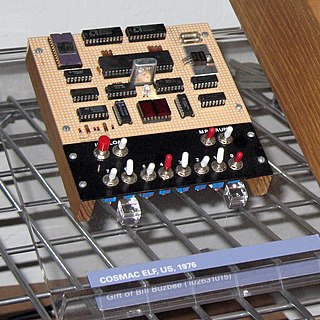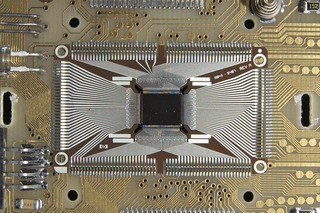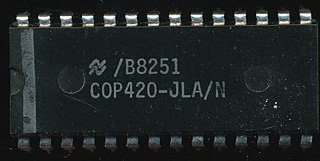
The MOS Technology 6502 is an 8-bit microprocessor that was designed by a small team led by Chuck Peddle for MOS Technology. The design team had formerly worked at Motorola on the Motorola 6800 project; the 6502 is essentially a simplified, less expensive and faster version of that design.

The 6800 is an 8-bit microprocessor designed and first manufactured by Motorola in 1974. The MC6800 microprocessor was part of the M6800 Microcomputer System that also included serial and parallel interface ICs, RAM, ROM and other support chips. A significant design feature was that the M6800 family of ICs required only a single five-volt power supply at a time when most other microprocessors required three voltages. The M6800 Microcomputer System was announced in March 1974 and was in full production by the end of that year.

The Intel MCS-51 is a single chip microcontroller (MCU) series developed by Intel in 1980 for use in embedded systems. The architect of the Intel MCS-51 instruction set was John H. Wharton. Intel's original versions were popular in the 1980s and early 1990s, and enhanced binary compatible derivatives remain popular today. It is a complex instruction set computer, but also has some of the features of RISC architectures, such as a large register set and register windows, and has separate memory spaces for program instructions and data.
x86 assembly language is the name for the family of assembly languages which provide some level of backward compatibility with CPUs back to the Intel 8008 microprocessor, which was launched in April 1972. It is used to produce object code for the x86 class of processors.

The MSP430 is a mixed-signal microcontroller family from Texas Instruments, first introduced on 14 February 1992. Built around a 16-bit CPU, the MSP430 was designed for low power consumption embedded applications and low cost.
In computer engineering, Halt and Catch Fire, known by the assembly language mnemonic HCF, is an idiom referring to a computer machine code instruction that causes the computer's central processing unit (CPU) to cease meaningful operation, typically requiring a restart of the computer. It originally referred to a fictitious instruction in IBM System/360 computers, making a joke about its numerous non-obvious instruction mnemonics.
Fetching the instruction opcodes from program memory well in advance is known as prefetching and it is served by using a prefetch input queue (PIQ). The pre-fetched instructions are stored in a queue. The fetching of opcodes well in advance, prior to their need for execution, increases the overall efficiency of the processor boosting its speed. The processor no longer has to wait for the memory access operations for the subsequent instruction opcode to complete. This architecture was prominently used in the Intel 8086 microprocessor.

The COSMAC is an 8-bit microprocessor family introduced by RCA. It is historically notable as the first CMOS microprocessor. The first production model was the two-chip CDP1801R and CDP1801U, which were later combined into the single-chip CDP1802. The 1802 represented the majority of COSMAC production, and today the entire line is known simply as the RCA 1802.

The COSMAC VIP (1977) was an early microcomputer that was aimed at video games. Essentially, it was a COSMAC ELF with a supplementary CDP1861/CDP1864 video display chip. For a price of US$275, it could be purchased from RCA by mail order. It came in kit form, and had to be assembled. Its dimensions were 22 × 28 cm, and it had an RCA 1802 processor; along with a crystal clock operating at 1.76 MHz. It had 2 KB of RAM, which could be expanded to 4 KB on board, and 32 KB via an expansion slot. Its 5V DC CDP18S023 power supply had an output of 600 mA. I/O ports could be added to connect to sensors, interface relays, an ASCII keyboard, or a printer.

The COSMAC Elf was an RCA 1802 microprocessor-based computer described in a series of construction articles in Popular Electronics magazine in 1976 and 1977. Through the back pages of electronics magazines, both Netronics and Quest Electronics offered low-priced, enhanced kits that were based on this design. The system was a very early single-board personal computer. It was operated without built-in ROMs and programs were entered directly with help of the CPU integrated DMA using 8 toggle switches and an Input push button.

The Fairchild F8 is an 8-bit microprocessor system from Fairchild Semiconductor, announced in 1974 and shipped in 1975. The original processor family included four main 40-pin integrated circuits (ICs); the 3850 CPU which was the arithmetic logic unit, the 3851 Program Storage Unit (PSU) which contained 1 KB of program ROM and handled instruction decoding, and the optional 3852 Dynamic Memory Interface (DMI) or 3853 Static Memory Interface (SMI) to control additional RAM or ROM holding the user programs or data. The 3854 DMA was another optional system that added direct memory access into the RAM controlled by the 3852.

The Zilog Z8 is a microcontroller architecture, originally introduced in 1979, which today also includes the Z8 Encore!, eZ8 Encore!, eZ8 Encore! XP, and eZ8 Encore! MC families.

The Saturn family of 4-bit (datapath) microprocessors was developed by Hewlett-Packard in the 1980s first for the HP-71B handheld computer and then later for various HP calculators. It succeeded the Nut family of processors used in earlier calculators. The original Saturn chip was first used in the HP-71B hand-held BASIC-programmable computer, introduced in 1984. Later models of the family powered the popular HP 48 series of calculators. The HP48SX and HP48S were the last models to use genuine Saturn processors manufactured by HP. Later calculator models used Saturn processors manufactured by NEC. The HP 49 series initially used the Saturn CPU as well, until the NEC fab could no longer manufacture the processor for technical reasons in 2003. Therefore, starting with the HP 49g+ model in 2003, the calculators switched to a Samsung S3C2410 processor with an ARM920T core which ran an emulator of the Saturn hardware in software. In 2000, the HP 39G and HP 40G were the last calculators introduced based on the actual NEC fabricated Saturn hardware. The last calculators based on the Saturn emulator were the HP 39gs, HP 40gs and HP 50g in 2006, as well as the 2007 revision of the hp 48gII. The HP 50g, the last calculator utilizing this emulator, was discontinued in 2015 when Samsung stopped producing the ARM processor on which it was based.
TLCS is a prefix applied to microcontrollers made by Toshiba. The product line includes multiple families of CISC and RISC architectures. Individual components generally have a part number beginning with "TMP". E.g. the TMP8048AP is a member of the TLCS-48 family.

The Intersil 6100 is a single-chip microprocessor implementation of the 12-bit PDP-8 instruction set, along with a range of peripheral support and memory ICs developed by Intersil in the mid-1970s. It was sometimes referred to as the CMOS-PDP8. Since it was also produced by Harris Corporation, it was also known as the Harris HM-6100. The Intersil 6100 was introduced in the second quarter of 1975, and the Harris version in 1976.
Each time Intel launched a new microprocessor, they simultaneously provided a system development kit (SDK) allowing engineers, university students, and others to familiarise themselves with the new processor's concepts and features. The SDK single-board computers allowed the user to enter object code from a keyboard or upload it through a communication port, and then test run the code. The SDK boards provided a system monitor ROM to operate the keyboard and other interfaces. Kits varied in their specific features but generally offered optional memory and interface configurations, a serial terminal link, audio cassette storage, and EPROM program memory. Intel's Intellec development system could download code to the SDK boards.
RL78 Family is a 16-bit CPU core for embedded microcontrollers of Renesas Electronics introduced in 2010.

The STM8 is an 8-bit microcontroller family by STMicroelectronics. The STM8 microcontrollers use an extended variant of the ST7 microcontroller architecture. STM8 microcontrollers are particularly low cost for a full-featured 8-bit microcontroller.
Joseph A. Weisbecker was an early microprocessor and microcomputer designer and researcher, as well and designer of toys and games. He was a recipient of the David Sarnoff award for outstanding technical achievement, recipient of IEEE Computer magazine's "Best Paper" award, as well as several RCA lab awards for his work.

The COP400 or COP II is a 4-bit microcontroller family introduced in 1977 by National Semiconductor as a follow-on product to their original PMOS COP microcontroller. COP400 family members are complete microcomputers containing internal timing, logic, ROM, RAM, and I/O necessary to implement dedicated controllers. Some COP400 devices were second-sourced by Western Digital as the WD4200 family. In the Soviet Union several COP400 microcontrollers were manufactured as the 1820 series.














